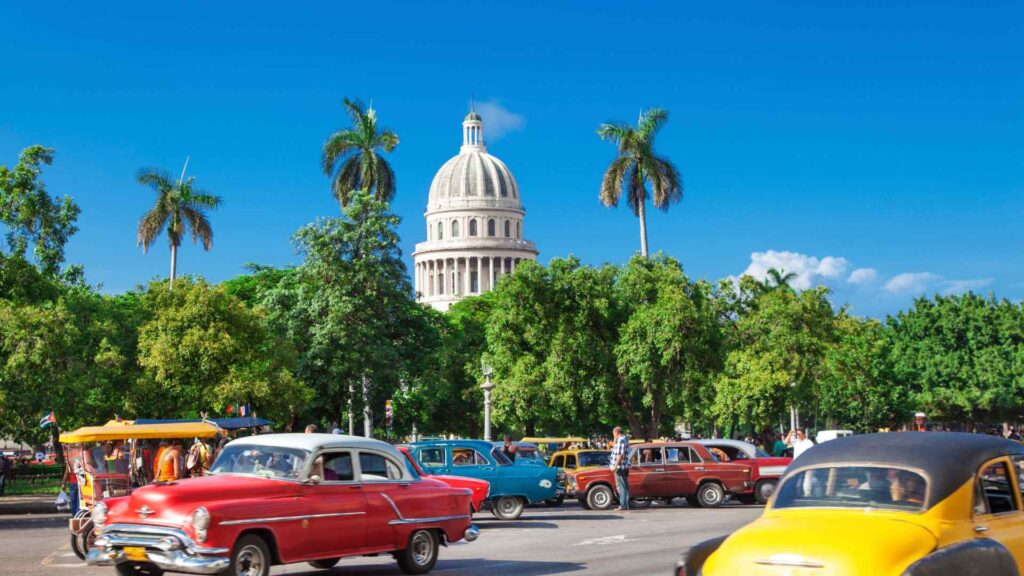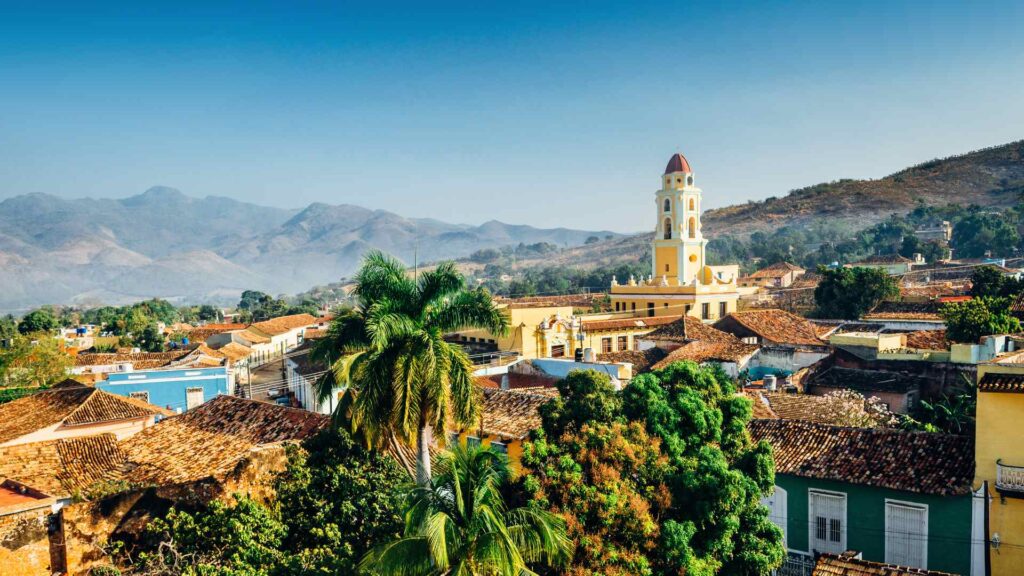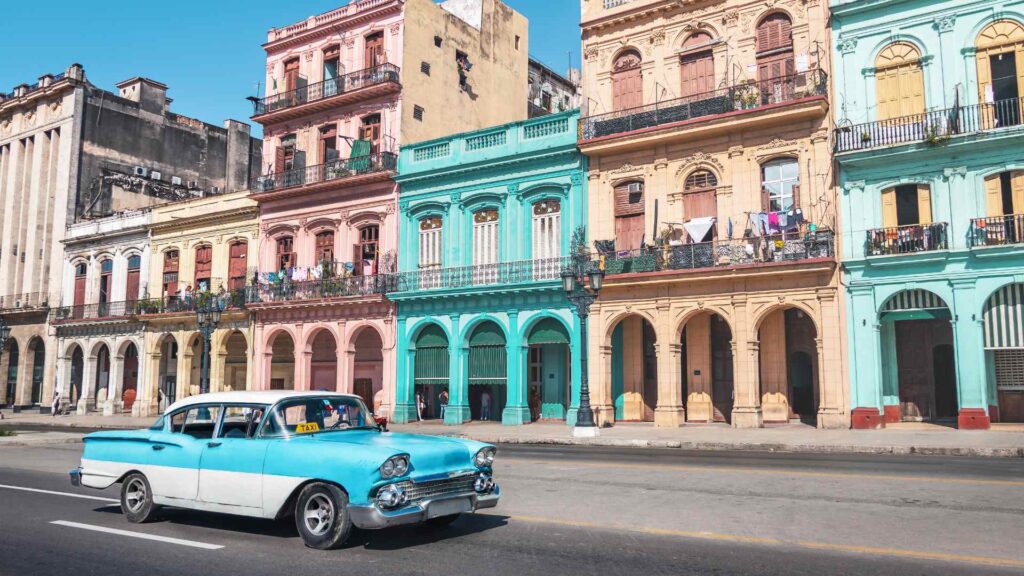Cuba is a land of vibrant culture, stunning landscapes, and intriguing history.
Whether you’re drawn to its revolutionary past, iconic music, or lush scenery, there’s something magical about this island nation.
This guide uncovers 145 fascinating facts about Cuba, celebrating its uniqueness across history, culture, food, and more.
Historical Highlights of Cuba
- Cuba was “discovered” by Christopher Columbus in 1492, but it was already inhabited by the Taíno people.
- Havana was founded in 1519, making it over 500 years old.
- Cuba was the last Spanish colony in the Americas to gain independence in 1898.
- The country played a pivotal role in the Cold War during the Cuban Missile Crisis of 1962.
- José Martí, a key figure in Cuban independence, is considered a national hero.
- The U.S. controlled Cuba for four years after the Spanish-American War.
- Fidel Castro led the Cuban Revolution, overthrowing Batista in 1959.
- Cuba was the first country in the Americas to legalize same-sex marriage.
- The country’s flag, designed in 1849, has remained unchanged since independence.
- Slavery was abolished in Cuba in 1886, later than in many other nations.
- Havana’s Malecón seawall has withstood hurricanes for over 100 years.
- Ernest Hemingway spent nearly 20 years living and writing in Cuba.
- The Bay of Pigs invasion in 1961 was a failed U.S.-backed military operation.
- Che Guevara, an Argentine revolutionary, is immortalized in Cuban culture.
- The country maintains some of the oldest architecture in the Caribbean.

Cuba’s Unique Culture
- Cuba is a blend of Spanish, African, and Indigenous influences.
- Salsa, mambo, and cha-cha originated in Cuba.
- The Buena Vista Social Club popularized Cuban music worldwide.
- Santería, a syncretic religion, blends African traditions with Catholicism.
- Dominoes is a favorite pastime in Cuba, often played in the streets.
- Cuban cigars are world-renowned for their quality and craftsmanship.
- National poet Nicolás Guillén is famous for Afro-Cuban themes.
- Baseball is Cuba’s most popular sport.
- Classic American cars from the 1950s are a symbol of Cuban ingenuity.
- The Havana Film Festival celebrates Latin American cinema.
- Cuban ballet is internationally acclaimed for its precision and artistry.
- The Tropicana Club has been a world-famous cabaret since the 1930s.
- “Guantanamera” is considered Cuba’s unofficial national anthem.
- Afro-Cuban jazz has profoundly influenced global music.
- Cuba is a UNESCO-listed hub for oral and intangible cultural heritage.
Breathtaking Cuban Nature
- Cuba is the largest island in the Caribbean.
- Varadero Beach is one of the most beautiful beaches in the world.
- The island has over 3,000 miles of coastline.
- The Zapata Swamp is home to crocodiles and rare bird species.
- Cuba’s coral reefs are among the most pristine in the Caribbean.
- The Sierra Maestra mountain range was a revolutionary hideout.
- Alejandro de Humboldt National Park is a UNESCO World Heritage Site.
- The Cuban solenodon is a rare mammal found only on the island.
- Viñales Valley is famous for its limestone mogotes.
- Cuba’s orchid gardens feature over 700 species of orchids.
- The country has no dangerous animals like large predators or venomous snakes.
- Cuba’s weather includes a distinct wet and dry season.
- The bee hummingbird, the world’s smallest bird, is native to Cuba.
- Over 350 species of birds have been recorded in Cuba.
- The island boasts more than 50 protected areas for biodiversity.

Cuban Cuisine and Drinks
- Cuban coffee, known as cafecito, is strong and sweet.
- The mojito, a refreshing cocktail, originated in Havana.
- Ropa vieja, a shredded beef dish, is Cuba’s national dish.
- Cuban sandwiches are famous worldwide but are a U.S. invention.
- Tostones, twice-fried plantains, are a popular side dish.
- Congrí is a savory mix of rice and black beans.
- Lechon asado, roast pork, is a festive favorite.
- Cuban flan is a creamy caramel dessert.
- Rum is a key export and a cultural staple in Cuba.
- Guarapo, sugarcane juice, is a refreshing drink found on the streets.
- Pastelitos are puff pastries filled with guava or cheese.
- Tropical fruits like mango, guava, and papaya abound in Cuban markets.
- Croquetas, fried bites filled with ham or cheese, are a popular snack.
- Cristal and Bucanero are two beloved Cuban beer brands.
- Cuba’s street food scene includes sandwiches, fritters, and churros.
Modern Life in Cuba
- The Cuban government provides free education and healthcare to its citizens.
- Internet access has only recently become widespread in Cuba.
- Classic cars double as taxis in Havana.
- Cuba has two currencies: CUP for locals and MLC for tourists.
- Tourism is one of the island’s largest economic sectors.
- Most Cuban homes have small gardens called organopónicos.
- Public transportation includes shared taxis called “almendrones.”
- Music and dance are integral to daily Cuban life.
- Street art and murals are common in cities like Havana.
- Schools teach a mix of academic and practical skills.
- Solar energy is increasingly used in rural areas.
- Baseball games are a communal affair, often drawing large crowds.
- Soap operas are a popular form of entertainment.
- People often gather on the Malecón for socializing and live music.
- The government rations food to ensure fair distribution.

Fascinating Extra Facts About Cuba
- Cuba is the only Communist country in the Western Hemisphere.
- Boxing is a dominant sport, with Cubans excelling in the Olympics.
- The Cuban literacy rate is 99.8%, among the highest in the world.
- The world’s longest cigar, measuring 81.8 meters, was rolled in Cuba.
- The country has a unique ecosystem with hundreds of endemic species.
- Cuba’s electricity is largely generated from domestic oil.
- Havana’s Capitolio building resembles the U.S. Capitol.
- Santa Clara is home to a Che Guevara mausoleum and museum.
- Cuban music heavily influenced American jazz and salsa.
- The country has 11 million people spread across 15 provinces.
Cuba is the birthplace of salsa dancing, inspiring dancers worldwide.
The Havana Cathedral is a stunning example of Baroque architecture.
Cuba has one of the highest doctor-to-patient ratios globally.
Hemingway’s favorite Havana bar, La Bodeguita del Medio, is a tourist hotspot.
Cuban cigars are hand-rolled using centuries-old techniques.
The Tropicana Cabaret has entertained audiences for over 80 years.
Cuba has over 200 bays and 4,000 cays and islets to explore.
The Bacardi family originated in Santiago de Cuba before relocating.
Camagüey’s labyrinthine streets were designed to confuse pirates.
The Cuban Missile Crisis lasted just 13 days but almost caused global disaster.
Fidel Castro survived over 600 assassination attempts.
The Bay of Pigs, or Playa Girón, is now a peaceful beach area.
Santiago de Cuba is known as the cradle of the Cuban Revolution.
Cuba’s national tree is the royal palm, a symbol of resilience.
The country has its own breed of dog called the Havanese.- Cuba’s Rich Arts Scene
Alicia Alonso, a legendary ballerina, put Cuban ballet on the global map.
Cuban posters are considered collectible works of art.
The island boasts numerous art galleries, particularly in Havana.
Santiago’s Carnival is the largest and most vibrant in the Caribbean.
The National Museum of Fine Arts in Havana showcases Cuban art from colonial times to modernity.
Cuban street musicians perform an eclectic mix of rhythms.
The Casa de la Música venues are iconic spots for live performances.
Afro-Cuban rhythms like rumba and son are deeply tied to the country’s heritage.
Cuban literature flourished with writers like Alejo Carpentier and Leonardo Padura.
Handmade leather-bound journals are a unique Cuban craft.
The Havana International Jazz Festival attracts world-class performers.
Murals depicting Cuban leaders and cultural icons adorn city walls.
Film lovers flock to Cuba’s annual Latin American Film Festival.
Santiago de Cuba is a hotspot for trova music.
Craft markets are brimming with sculptures, jewelry, and paintings.
Natural Phenomena and Eco-Treasures
The Sierra del Rosario Biosphere Reserve is a UNESCO site for sustainable development.
Cuba has more caves than any other Caribbean nation.
The world’s largest colony of flamingos lives in the Jardines del Rey.
The Punta Francés Marine National Park is a diver’s paradise.
Cuba’s tropical climate allows for year-round agriculture.
Desembarco del Granma National Park features dramatic coastal cliffs.
Orchids bloom in vibrant arrays across the island.
The Parrotfish helps maintain Cuba’s coral reef ecosystems.
Unique to Cuba, the trogon bird is the country’s national bird.
The “Valle de los Ingenios” (Valley of the Sugar Mills) is a lush historical site.
Mangroves along Cuba’s coasts play a vital role in preventing erosion.
Cuban pine forests are a serene retreat for nature enthusiasts.
Fossilized remains of extinct animals like the Megalodon have been found here.
The Escambray Mountains offer breathtaking hiking trails.
Cuba’s easternmost point, Punta de Maisí, features a historic lighthouse.
Unbelievable Cuban Facts
Cuba is one of the few countries where Coca-Cola is not officially sold.
The island has no McDonald’s or Starbucks locations.
Internet connections in Cuba were only introduced in the 21st century.
The country celebrates its national holiday, Día de la Rebeldía Nacional, on July 26.
Cuban schools require students to wear uniforms in designated colors by grade level.
Conclusion
Cuba’s vibrant culture, rich history, and stunning landscapes make it a fascinating destination. From its revolutionary legacy to its tropical biodiversity, there’s no shortage of wonders to explore.
Whether you’re planning a visit or just expanding your knowledge, these 145 facts provide a deep dive into the heart of Cuba.
